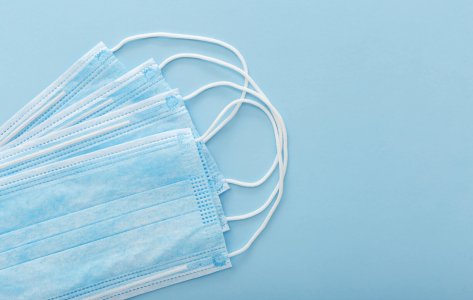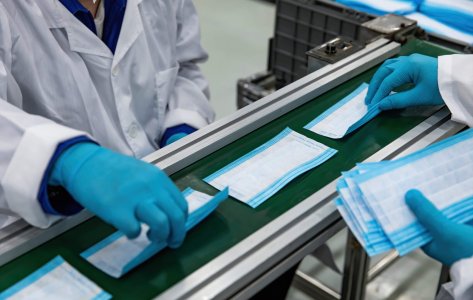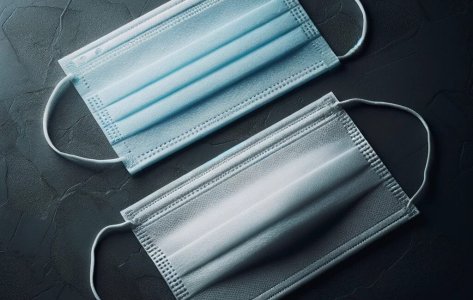- Swiss testing laboratory
ASTM F2100

Hassle-free testing experience
Need to get a product tested? No worries! To and fro logistics are on us; we collect your products, test them and, deliver them back to you.
Related tests for you
Quick understanding of the test
ASTM F2100 - Performance of materials used in medical face masks
Application
Mandatory test strains
- Staphylococcus aureus
- Bacterial Filtration Efficiency (BFE): Measures bacteria filtration using aerosolized S. aureus.
- Differential Pressure (Delta P): Assesses breathability by measuring airflow resistance.
- Particulate Filtration Efficiency (PFE): Tests filtration of submicron particles.
- Fluid Resistance: Evaluates synthetic blood penetration under varying pressures.
- Flammability: Tests burn time under controlled flame exposure.
- Ensures comprehensive assessment of medical face masks by providing various testing methods.
- Establishes consistent performance benchmarks for manufacturers, ensuring reliable and compliant face masks for patient care and surgical use.
Turnaround Time
Passing criteria
Masks must meet specific performance benchmarks based on their classification (Levels 1, 2, or 3) in parameters such as bacterial filtration efficiency (≥ 95% or 98%), resistance to synthetic blood, and breathability.
Do you have a product that needs testing?
Abstract
The ASTM F2100 test specification defines the classification and performance of materials used in medical face masks. These masks are intended for use in healthcare settings, such as surgeries and patient care, to protect both the wearer and others from potential exposure to harmful particles and fluids.
As stated in this standard, the performance of medical face mask materials is evaluated based on the following criteria:
- Bacterial Filtration Efficiency (BFE)
- Differential Pressure
- Sub-Micron Particulate Filtration Efficiency
- Resistance to Penetration by Synthetic Blood
- Flammability
Medical face masks are classified into three performance levels under ASTM F2100 based on their barrier properties:
Level 1 barrier
Level 1 masks are tested for their ability to filter sub-micron particles, resist synthetic blood penetration at minimum velocity, and maintain bacterial filtration efficiency. These masks are normally used in low-risk environments such as doctor’s offices or even public transportation. The Level 1 mask is light and made from breathable materials. It provides basic protection against large respiratory droplets and particles. They are typically secured with ear loops or ties.
Level 2 barrier
Level 2 masks offer a moderate level of protection. Testing includes filtration of sub-micron particles and resistance to synthetic blood penetration at moderate velocity. They are typically used in moderate-risk situations, such as in dental procedures or while visiting hospitals. These masks are manufactured using thicker materials than Level 1 masks and can effectively block at least 98% of particles as small as 0.1 microns.
Level 3 barrier
The Level 3 masks offer the most protection. These masks are tested for the penetration of synthetic blood at the maximum velocities, particulate filtration efficacy, and bacterial filtration efficacy. These masks are used in situations with high risks of exposure, for example, during surgeries or procedures that involve bodily fluid or aerosol exposure. ASTM Level 3 masks are manufactured from the thickest material and hence are capable of blocking 98% of the particles which are usually as small as 0.1 microns. Their bacterial filtration efficacy has to be a minimum of 98% along with less than 160 mm Hg differential pressure.
Test Methods for Performance of Materials Used in Medical Face Masks
Bacterial Filtration Efficiency (BFE)
BFE refers to the ability of the mask material to filter out aerosolized bacteria. The standard test methodology followed is ASTMF 2101 and measures the percentage of bacteria prevented from passing the material. The test involves passing an aerosolized culture of S. aureus through the mask material with controlled airflow. The bacteria that get collected on the agar plates are then incubated and enumerated. BFE is calculated by comparing the number of bacterial colonies that pass through the mask to a control sample.
Differential Pressure (Delta P)
The test serves to quantify the breathability of the mask, which is defined as the resistance to the airflow across the material. The test follows the MIL-M- 36954C standard, where the differential pressure is expressed in mmH2O/ cm². In this test, the mask material is placed in a testing apparatus with a controlled airflow. Air is passed through the mask material at a specified and constant flow rate. The difference in air pressure is measured on both sides of the mask material to determine the breathability.
Particulate Filtration Efficiency (PFE)
PFE is the measure of the mask’s capability to filter submicron particles, usually ranging between 0.1 to 5 microns. The standard test method used is ASTM F2299 which is specifically designed to test the capability of the mask for filtering viral-sized particles. In this process, a test sample of mask material is placed in the testing apparatus, where an aerosol containing particles (ranging from 0.1 to 5 microns) is generated and passed through the mask material. The amount of particles passing through the material is measured against the total number of particles that were introduced. The resulting PFE is, therefore, expressed as the percentage of particles blocked by the mask material. The higher the percentage, the better the filtration efficiency.
Fluid Resistance
Fluid resistance determines the mask’s resistance to the penetration of synthetic blood at different pressures. In this test (conducted as per ASTM F1862), the mask material is mounted in a testing apparatus. A fixed volume of synthetic blood is slashed at the mask at varying pressures (80, 120, and 160 mm Hg). The material is observed for the penetration of synthetic blood through the inner layer of the mask. The mask passes the test if no blood penetrates the inner layers of the mask material at the tested pressure.
16 CFR Flammability Test
The 16 CFR Part 1610 standard, generally used in flammability tests, explains the requirements for flammability of textile products and offers test methods. This standard was developed by the National Institute of Occupational Health and Safety (NIOSH).
The test involves placing a strip of the mask material in a flammability testing apparatus. The material is exposed to a controlled flame for a specified period. The burn time for the material is recorded.
Importance of ASTM F2100
The ASTM F2100 standard is vital for both manufacturers and healthcare professionals. For manufacturers, it provides a framework for assessing the materials used for product development thus aiding in developing medical face masks that meet set standards of performance within the industry. During the development of the product, materials are tested for bacterial filtration, breathability, and fluid resistance to enable manufacturing companies to create products that are in compliance with regulatory demands.
Masks tested against this standard provide health professionals with an assurance of the level of protection that they can expect from these masks. In return, this allows them to choose appropriate masks according to the risk level in specific medical environments and ensure both their safety and the safety of their patients.
Benefits of Testing
- Reduced liability risk: Testing ensures that the masks meet the highest possible safety standards which helps reduce the risk of liability issues for manufacturers and healthcare providers in case of product failure during critical procedures.
- Improved supply chain efficiency: Compliance with the standard may facilitate easier approval processes, hence contributing to a more seamless production workflow and reducing the time taken for market entry.
- Enhanced product differentiation: Meeting the standard requirements enables manufacturers to differentiate their products from those of the competitors by offering proven, high-performing masks to address a wide range of risks specific to healthcare settings.
- Global market access: Successfully tested products are more likely to meet international regulatory requirements thus providing manufacturers the ability to enter global markets and increase sales opportunities.
Limitations
It’s important to note that while ASTM F2100 testing assesses certain key performance factors of medical face masks, they do not evaluate all aspects of mask effectiveness. Factors such as breathability, comfort, and comprehensive barrier protection, particularly for respiratory protection, which may be required in certain healthcare environments are not fully covered by this standard.
Relevant test methods
At MIS, we also provide ASTM F2101, EN 14683 and ISO 22609 services for testing various performance parameters of medical face mask materials such as breathability, particle filtration efficiency, splash resistance and more.
Why choose Microbe Investigations (MIS)?
Ensure the safety and effectiveness of your medical face masks with ASTM F2100 testing services. At Microbe Investigations Switzerland, we provide expert testing services to help you meet regulatory standards and deliver high-quality products. Contact us today to learn more about our face mask testing solutions.
Frequently Asked Questions

DR. Martinoz Scholtz
The ASTM F2100 standard covers the performance requirements and testing methods for materials used in medical face masks. It focuses on parameters such as bacterial filtration efficiency, differential pressure-breathability, sub-micron particulate filtration efficiency, synthetic blood penetration resistance, and flammability.
Surgical Face Masks and General-Use Masks can be tested with ASTM F2100.
ASTM F2100 test takes 8-12 weeks to complete.
PFE stands for Particulate Filtration Efficiency, which refers to the efficiency with which the mask material may filter out aerosolized particles of less than one micron. It is expressed as a percentage of the particles that the mask material is capable of capturing during testing. The higher the value of PFE, the better the filtration performance.
Differential Pressure (Delta P) measures the breathability of the mask material by determining the pressure drop across the mask during use. It is an indication of how easily air can pass through the mask. The lower differential pressure values indicate greater breathability.
ASTM F2100 categorizes medical face masks into three levels of protection: Level 1, which is for low-risk situations; Level 2, for moderate-risk situations; and Level 3, involving high risks, like in surgical procedures. This categorization helps healthcare professionals choose the right mask based on the potential exposure to fluids and particles.
Meet the best of the blend of
R&D, Efficacy Testing,
Innovation and Passionate
Experts at MIS.





Explore More
Face masks are incorporated into
Face masks prevent airborne contamination,
Face masks are crucial for






